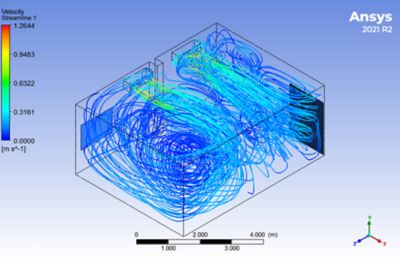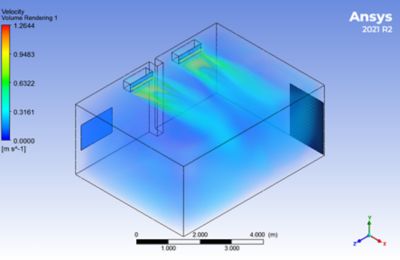-
-
학생용 무료 소프트웨어에 액세스하기
차세대 엔지니어에게 힘을 실어주는 Ansys
학생들은 세계적 수준의 시뮬레이션 소프트웨어를 무료로 이용할 수 있습니다.
-
지금 바로 Ansys에 연결하십시오!
미래를 설계하기
시뮬레이션이 다음 혁신을 어떻게 지원할 수 있는지 알아보려면 Ansys와 연결하십시오.
국가
무료 트라이얼
제품 및 서비스
학습하기
회사 정보
Back
제품 및 서비스
ANSYS BLOG
August 3, 2022
Something in the Air
IIT Bombay students use Ansys Fluent to estimate how air circulation can minimize virus spread
Fast-tracking the training of future engineers while helping them become productive world citizens might seem like an ambitious undertaking. But when the fourth-year students in Murallidharan’s fall 2021 Computational Fluid Dynamics & Heat Transfer course took on the complex problem of analyzing ventilation in campus facilities during the COVID-19 pandemic, the experience resulted in decidedly down-to-earth applications.
Equipped with Ansys Student — a free download that includes Ansys Fluent — on each of their laptops, class members found out how to use advanced learning to solve practical (and in this case, universal) problems: estimating how frequently the air inside a confined space needs to be circulated to minimize the spread of infection and how to introduce more fresh air into the enclosed environment.
Mixing, Matching, and Aha! Moments
Murallidharan expects that the students who complete her course will be able to understand fluid flow in any environment they’ll eventually work in, whether they’ll be designing airplane wings, heat transfer systems for electronics, or wind turbines.
That’s why she appreciates the flexibility of Fluent, which is used by professional engineers in multiple disciplines.
Before they can graduate to Fluent, so to speak, her students spend their first years at IIT Bombay calculating fluids phenomena the old-fashioned way: writing equations and coding computer programs.
Mastering the fundamentals is necessary and provides a firm footing in fluid dynamics. However, learning exercises don’t provide the kind of insight young engineers will be required to have on the job.
“Because the students have to do all these steps themselves, the problem to which they will apply this fundamental capability is very rudimentary in the sense that they would probably take a very ideal room and study how air will settle into it,” Murallidharan says. “They’re spending most of their time trying to learn the very core of these equations. But at the end, they have difficulty understanding how the math can translate to helping industry.”
By contrast, Fluent lets the students easily see complex conditions without having to actually type and code every bit of it, Murallidharan says.
“Engineers can select the equations they need in Fluent, and they can mix and match different models,” she explains. “Fluent will translate those complex conditions very quickly into a visual animation. For students, Fluent lets them relate the engineering aspects to a design and helps them quickly assess the impact of flow problems and ideate solutions.”
Those robust numerical and functional capabilities seem purpose-built for Murallidharan’s class, which had two parallel tracks. Students spent part of their time learning concepts and then used Fluent to solve actual problems that build on foundational computational fluid dynamics (CFD) theory. There was a lot of back-and-forth learning, Murallidharan says, that helped students better understand the fundamentals and the applications and enabled them to see what the concepts do in the real world. It also resulted in many “aha!” moments.

IIT Bombay campus building.
Plotting a Safe Return
Bringing real-world issues into the engineering classroom is often tricky, and is even trickier when a pandemic prevents the students from being in the classroom themselves and they have to rely completely on remote, online learning.
Yet these adverse circumstances turned out to provide a unique opportunity for these young engineering students. With the problem of COVID-19 all around them, it became an obvious focus for their semester-long project. Figuring out whether labs and other shared learning spaces were ventilated well enough to prevent the transmission of the virus would help Murallidharan’s students:
- Learn that fundamental CFD is not something removed from their lives. One objective, she says, was to show how these “cold, very dry equations fit into our very chaotic world.”
- Recognize how CFD can be used to solve socially relevant problems and make a difference in people’s lives. Students and engineers are often disconnected from society, Murallidharan says. But learning to contribute to the world — even if it’s something like designing a simple pump that helps a farmer irrigate his crops — can be more valuable than “landing the high-paying job.”
- Be able to provide specific, concrete recommendations to overcome a challenge. As she notes, if the issue they were working on was too abstract or so large that there’s no way to arrive at a feasible solution (e.g., ending pollution), it would be demotivating.
Ultimately, the students’ work could have a huge and meaningful impact on the technology college itself. If they could figure out how to improve ventilation, or at least ensure that what’s already there is safe, it might be possible for everyone to return to campus sooner. Some questions remained, though: How could any of this be done without the students accessing the facilities that required analysis? And how could Fluent help?

Streamlines depicting the flow path taken by the air entering the room from the air conditioners.

Volume rendering of the velocity of the flow field inside the room.
All Problems are Local
They say that all problems are local; if that’s true, so are the solutions. At least they were in this case.
With a campus visit off-limits, Murallidharan asked the students to start looking at ventilation issues in their own homes. That quickly brought the issue into context, she says, as everyone was interested in making the rooms where they and their families live as safe as possible.
Broadening the investigation involved taking advantage of an ace in the hole. Although IIT Bombay was largely closed, the school allowed a handful of Ph.D. candidates to come onto campus. They served as mentors to Murallidharan’s class, answering questions about the labs and other spaces being analyzed and taking photos to provide at least a virtual sightline.
Working on the assumption that recirculated air was likely laden with the coronavirus, the students used Fluent to simulate the effects of bringing in fresh air and drawing out the old. Murallidharan says that Fluent’s robust meshing and simulation capabilities “made a world of difference,” enabling students to mesh large rooms efficiently and easily incorporate various flow effects such as ceiling fans, exhaust fans, and air turbulence parameters.
“There is no way the kids could have coded the mesh themselves for such complex geometries as a room,” she says. “Fluent’s sphere of influence mesh sizing easily let them identify regions where they wanted more complex or final meshes. They could see why some meshes didn’t work, make changes quickly, and then see how that affected the results. It was a huge learning experience.”
Using Fluent to visualize the flow of air in the rooms was also essential.
“Fluent’s animation capabilities actually showed them how the flow behaved rather than them having to imagine something,” Murallidharan says. “They saw flow visualized in the rooms, tried out different simulation options available in Fluent, and worked with add-on numerical capabilities, such as solving for a user-defined scalar (UDS), which was crucial for predicting the residence time of air in various parts of the room. Ultimately, the students realized the importance of ventilating dead zones to limit infection spread.”
An Elegant Solution
In the end, the students recommended an elegant, cost-efficient, simple, and universal solution: adding exhaust fans to the spaces and leaving any windows open just a bit to increase flow circulation and velocity. From start to finish, the work took just four months. There was no coding from scratch, just a few hours of clicking per week on their computers. The short timetable made the experience especially empowering, Murallidharan says. Using Ansys Fluent accelerated the students’ abilities, and thanks to their study of something in the air, they’ll be able to hit the ground running as professionals.
Want to try Ansys Fluent? Get a free trial of Ansys Fluent today.